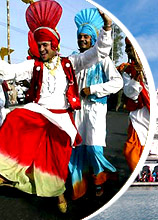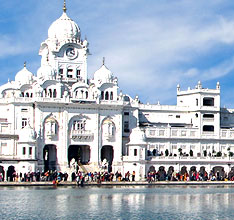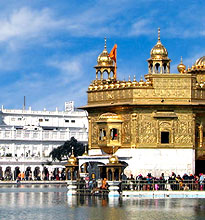 Jalandhar, called "Prasthala” at the time of Mahabharat and "Jullundur” in British times, is one of the important districts of Punjab. The legend goes that it is named after a demon king, Jaldhar, who is mentioned in Puranas and Mahabharata. According to another legend, Jalandhar was the capital of the kingdom of Raja Lav, son of Lord Rama. According to yet another version, Jalandhar is said to have derived its name from the vernacular term `Jalandhar’, meaning 'area inside the water’, i.e. the tract lying between the two rivers Sutlej and Beas. Another name of Jalandhar had been Trigarta. The place is watered by three rivers, Sutlej, Beas and Ravi.
Jalandhar, called "Prasthala” at the time of Mahabharat and "Jullundur” in British times, is one of the important districts of Punjab. The legend goes that it is named after a demon king, Jaldhar, who is mentioned in Puranas and Mahabharata. According to another legend, Jalandhar was the capital of the kingdom of Raja Lav, son of Lord Rama. According to yet another version, Jalandhar is said to have derived its name from the vernacular term `Jalandhar’, meaning 'area inside the water’, i.e. the tract lying between the two rivers Sutlej and Beas. Another name of Jalandhar had been Trigarta. The place is watered by three rivers, Sutlej, Beas and Ravi.Jalandhar is located on the intensively irrigated plain between the Beas and Sutlej rivers. It is surrounded by Ludhiana district in east, Kapurthala in west, Hosiharpur in north and Ferozepur in south. It covers an area of about 3,401 sq km. Administratively, the district is divided into 5 tehsils: Jalandhar-I, Jalandhar-II, Nakodar, Phillaur and Shahkot. Jalandhar, along with Multan, is the oldest surviving city of the Trigarta Empire (Punjab region) of Katoch Rulers, with reference in history as far back as AD 100. The Jalandhar Doab (the region surrounding the city between Beas and Sutlej rivers) also marked the eastern most territory of the empire of Alexander, the Great.
In 7th Century, when the famous Chinese traveler and pilgrim Hiuen Tsang visited India, during the reign of Harsha Vardhana, the Kingdom of Jalandhara or Trigartta was under the rule of Raja Utito (whom Alexander Cunningham identifies with the Rajput Raja Attar Chand of the Katoch dynasty). The Rajput Rajas appear to have continued their rule over the country right up to the 12th century, with occasional interruptions, but their capital was Jalandhar and Kangra formed an important stronghold. Jalandhar became the seat of Nath movement from 8th to 10th century AD, with one of its greatest saint being Jalandhar Nath. From the later half of the tenth century up to AD 1019, the district was included in the Shahi Kingdom of the Punjab and Jalandhar was an important city in the region.
Jalandhar was captured by the Faizullahpuria confederacy in 1766. Ranjit Singh annexed it in 1811, and in 1846, it became the headquarters of the territory acquired by the British after the first Sikh War. During British rule, Jalandhar city became the headquarters of the Division and District of the same name. It was the capital of Punjab from India's Independence (1947) until Chandigarh was built in 1953. Today, Jalandhar is one of the important tourist destinations and one of the fast growing industrialized sectors of Punjab. Sports goods, steel and iron re-rolling mills, rubber goods, electric goods, automobile parts, handloom and handicraft industry are the important trade sources of the district. It is a place of great antiquity, which is gradually expanding its scope of being a highly industrialized center of commercial activity.
Devi Talab Mandir
The famous Devi Talab Temple is situated in the heart of Jalandhar city, just 1 km from the railway station. It is believed to be more than 200 years old. The temple is dedicated to Goddess Durga and is one of the 51 Shakthi pithas in India. The image of Lord Shiva that is enshrined herein is called Bhisan Bhairav.
Jalandhar Excursions
The excursions from Jalandhar are no less exciting than the city itself. In fact, once in the city, you must make sure to visit the adjoining places as well. In the following lines, we have provided the details of some of the popular tourist places near Jalandhar.
How to Reach Jalandhar
Jalandhar can be conveniently reached by air, rail as well as road services. The city has a well-developed infrastructure, which keeps it connected to cities both within and outside the country. Let us know more about how to reach Jalandhar.
Pushpa Gujral Science City
Pushpa Gujral Science City is the biggest project of its kind in Northern India. It is set up in 72 acres of land, on the Jalandhar-Kapurthala Road. The city was built with the aim of educating the masses about the wonders of science in the most pleasant and entertaining manner.
St. Mary’s Cathedral Church
St. Mary's Cathedral Church is one of the famous religious as well as tourist places in Jalandhar. The Old Church was constructed by Rev. Fr. John Macodnnel in 1947, in the memory of St. Patrick. In 1955, the Catholic Mission of the Indian Punjab was raised to the status of Apostolic Prefecture, with its headquarter at Jalandhar. The church in the city subsequently became the Cathedral or the Mother Church of Punjab.
Serai Nurmahal
The small town Nurmahal, situated near Jalandhar, is famous for Serai Nurmahal, which was constructed for the travelers visiting the town. It is a historical inn, built by Nurjahan as an oriental example of oriental architecture. Nurjahan, the wife of Mughal Emperor Jehangir, built it with the help of Nawab Zakariya Khan, Governor of the Doab, between 1619 and 1621 A.D.
Shopping in Jalandhar
Jalandhar is one of the important districts in Punjab. It offers ample of options to shop, when it comes to the tourists. The city has both modern items and rich traditional items at display. Besides buying the usual urban stuffs, one can look out for the specialties of the region.
Tourist Attractions
Jalandhar has a rich tradition, which makes it one of the most popularly visited places in Punjab. It abounds in historic monuments like the Mausoleum of Imam Nasir, Phillaur Fort, Shiv Mandir, Devi Talab Mandir, Nakodazr Tombs, etc. With this article, explore the tourist places in Jalandhar, in detail.
Jalandhar Weather
The weather of Jalandhar is basically dry, except the humidity it experiences during the brief south-west monsoon season. The city experiences mainly four seasons in a year - summer, monsoon, post-monsoon and winter season. Let us gather some more information on the weather and climate of Jalandhar.











